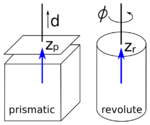Difference between revisions of "Assigning coordinate frames"
| Line 4: | Line 4: | ||
===Notation=== | ===Notation=== | ||
| − | The notation of the links and joints is shown in the figure below. A manipulator consists of <math>n</math> links that are connected with <math>n</math> joints. The links correspond to the rigid parts of an arm and the joints are the flexible connections between them. A joint is always assigned to the proximate link. So a link <math>L_i</math> is connected with its joint | + | The notation of the links and joints is shown in the figure below. A manipulator consists of <math>n</math> links that are connected with <math>n</math> joints. The links correspond to the rigid parts of an arm and the joints are the flexible connections between them. A joint is always assigned to the proximate link. So a link <math>L_i</math> is connected with its joint <math>J_i</math> to the end of link <math>L_{i-1}</math>. The proximate link <math>L_{i+1}</math> is then mounted to the end of <math>L_i</math> via its joint <math>J_{i+1}</math>. The first link <math>L_1</math> is mounted on the base via joint <math>J_1</math> and the end of the last link <math>L_n</math> corresponds to the end-effector. |
| − | The first link is mounted on the base via joint | ||
[[File:links.png|left|850px]] | [[File:links.png|left|850px]] | ||
Revision as of 16:09, 30 October 2015
| ← Back: Denavit-Hartenberg Convention | Overview: Denavit-Hartenberg Convention | Next: Denavit-Hartenberg parameters → |
To be able to determine the spatial relationship or transformation, respectively, between the links of a manipulator, local coordinate frames have to assigned to them first. There are several rules that have to be observed when assigning coordinate frames following the Denavit-Hartenberg convention.
Notation
The notation of the links and joints is shown in the figure below. A manipulator consists of  links that are connected with
links that are connected with  joints. The links correspond to the rigid parts of an arm and the joints are the flexible connections between them. A joint is always assigned to the proximate link. So a link
joints. The links correspond to the rigid parts of an arm and the joints are the flexible connections between them. A joint is always assigned to the proximate link. So a link  is connected with its joint
is connected with its joint  to the end of link
to the end of link  . The proximate link
. The proximate link  is then mounted to the end of
is then mounted to the end of  via its joint
via its joint  . The first link
. The first link  is mounted on the base via joint
is mounted on the base via joint  and the end of the last link
and the end of the last link  corresponds to the end-effector.
corresponds to the end-effector.

